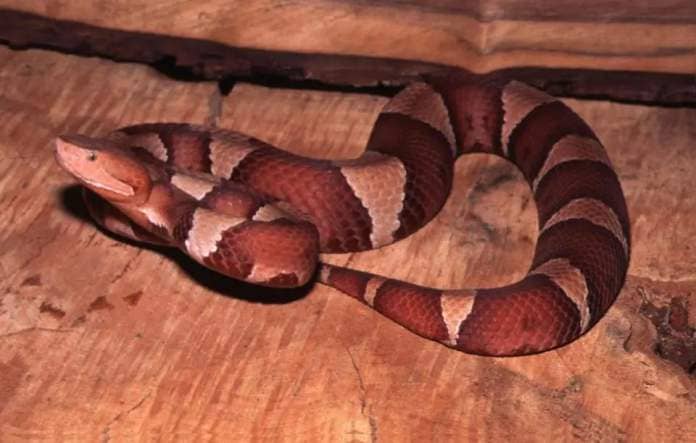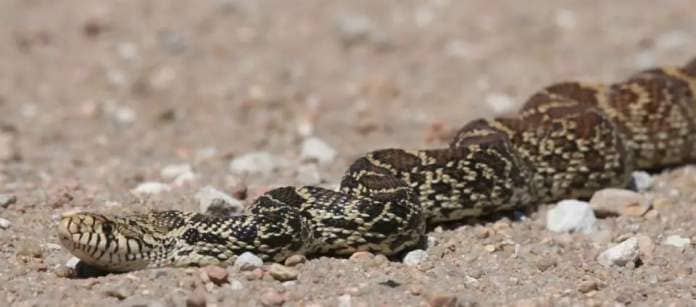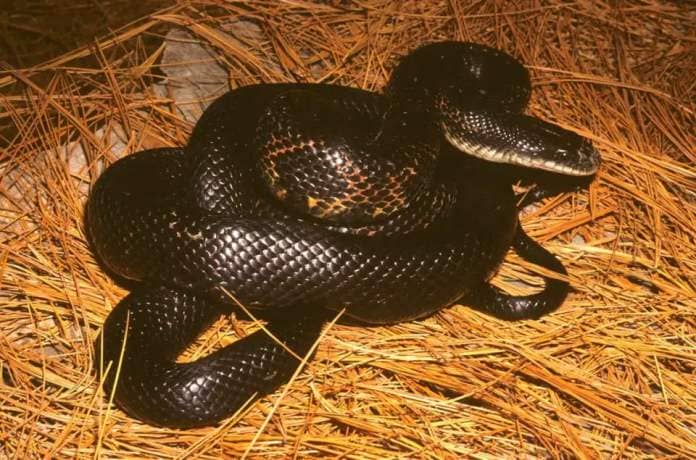If you step outside this summer, chances are you’ll see a snake or two slithering along.
There’s no need to worry as most snakes in Kansas and the Wichita area are harmless and help with rodent control. But if you aren’t familiar with snake species and what to look out for, seeing a snake in your yard can by frightening.
The Wichita Eagle spoke to two experts about common snakes in the area. Here’s a quick guide to help you identify any you spot this summer.
Venomous snakes near Sedgwick County
Venomous snakes are not very abundant in the Wichita area and around Sedgwick and Butler counties.
The term “venomous” refers to something that releases toxins through a sting or a bite, while the term “poisonous” refers to something that releases toxins upon consumption.
The only two types of venomous snakes spotted approaching Wichita are the broad-banded copperhead and the western massasauga, but none have been reported in the city limits.

The broad-banded copperhead is common in southwest Butler County and has been spotted 10 miles southeast of Wichita.
You can identify this snake by its pattern: light-ended crossbands that scope the entire body. Its colors vary, some common include gray, dark gray, light brown, brown with a gray head, brown or red. These snakes can usually reach 36 inches.

The western massasauga is the smallest rattlesnake in Kansas and has been spotted in every county surrounding Sedgwick. It is common near Cheney Lake and the Flint Hills.
This snake can be identified by its gray and brown blotches along its sides and back. These snakes usually reach up to 30 inches.
It’s monarch butterfly season once more. Here’s how to attract and spot them in Kansas
What to do if you spot a snake in Kansas
If you live in an area where these snakes are common, the best measure to take is to familiarize yourself with their characteristics, and if you come across one, leave it alone.
“If it’s not a concern just go about … as you always have been and nothing will probably ever happen,” said Travis Taggart, the director of The Center for North American Herpetology and research associate for the Sternberg Museum of Natural History at Fort Hays State University. “If it is a concern then look at pictures.”
The researcher said the majority of venomous snake bites occur when someone mistakenly steps on or touches one, usually hidden in grass.
“When you’re in an area where you suspect there might be a venomous snake, you just want to be careful where you put your hands and toes,” Taggart said.
If you do see a snake, it’s safe to take a look.
“It’s very safe to stand a few feet away and watch a snake, you don’t have to be worried about it coming after you to bite you,” Taggart said. “It may stand its ground … but you can stand there and watch it and eventually it will crawl away.”
If you don’t know what species of snake you’re looking at, there’s no fool proof way to immediately know if it’s dangerous. Some people use head shape — if the head is flat or diamond-shaped, the snake could be venomous — but some nonvenomous snakes can appear that way as a defense mechanism.
“The problem is a lot of nonvenomous snakes, when they feel threatened, will puff up and flatten their head, so then it gets confusing. And so a lot of nonvenomous snakes get killed because they’re putting on this threat display to scare you off and you just see this big flat head that you associate with venomous snakes,” said Daren Riedle, the wildlife diversity coordinator at the Kansas Department of Wildlife and Parks.
Kansas poison control fields thousands of reports for household products. When to call
Nonvenomous snakes in Wichita
Wichita is home to multiple nonvenomous species of snake, as well.

One of the most common ones you’ll see is a gophersnake, also called bullsnake. These can reach 6 to 7 feet long, according to Riedle, and are often confused for rattlesnakes. Gophersnakes have an upturned snout and a yellow body with a pattern of brown and black blotches.
Two types of gartersnakes, the common gartersnake and the plains gartersnake, are likely to be spotted this summer.

Common gartersnakes can be identified by their white, green or gray stomach with a stripe on either side of the body on the second or third row of scales. Plains gartersnakes look similar, with a stripe on each side on the third or fourth row of scales.

The western ratsnake, also called the black ratsnake, is another common type. You can identify this critter by its dark brown or black color, while some have patterns of dark splotches. The juvenile snakes look a bit different than the adult ratsnakes, with blotches of dark brown and a light grey color.
These nonvenomous snakes are usually the ones spotted the most around the area, Reidle said.
“Gophersnakes, black ratsnakes and gartersnakes do really well around human habitation. People kind of figure out these guys are harmless and they eat a lot of rodents,” Reidle said. “A lot of people kind of leave them be, that’s one of the reasons why you see so many in the urban settings.”
Riedle said another snake that’s abundant in the area is the eastern yellowbelly racer, but it often goes unseen because of how fast it moves.
These snakes can be identified by their grey/green color and yellow belly. The juveniles look different, sporting a tan/cream body and brown, gray or red blotches.
Hunting for mushrooms in Kansas? How to identify them and other tips before you dig
More about snakes in south-central Kansas
These are just a few of kinds of snakes spotted in the area. To take a look at all the species seen in Kansas and the Wichita area, the Kansas Herpetofaunal Atlas, run by Taggart, is an online tool to learn more about the critters.
There are also several local resources through the Great Plains Nature Center and the Sedgwick County Zoo you can use to familiarize yourself with the different species of snakes, as well.
If you’re interested in taking field trips with experts to learn about snakes, you can join the Kansas Herpetological Society.


